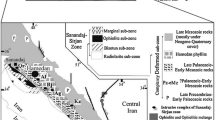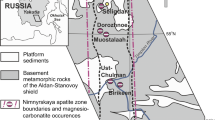Abstract.
At Gordon Butte (Crazy Mountains, Montana), agpaitic nepheline–syenite pegmatites intrude potassic alkaline rocks (principally, malignites and nepheline microsyenites). All pegmatite veins are composed predominantly of potassium feldspar, nepheline, prismatic aegirine, barytolamprophyllite, wadeite, eudialyte, loparite-(Ce) and altered rinkite ("vudyavrite") embedded in spherulitic and fibrous aegirine. Well-differentiated veins contain "pockets" filled with calcite, fluorapatite, mangan-neptunite, Mn–Ti-enriched prismatic aegirine, calcium catapleiite, and an unidentified Ca–Ti silicate. The potassium feldspar corresponds to Ba-rich sanidine with relatively low Na contents. The nepheline contains low levels of SiO2 and elevated Fe contents. The compositions of nepheline cluster in the lower portion of the Morozewicz–Buerger convergence field, indicating low-temperature crystallization and/or chemical re-equilibration of this mineral. The association of sanidine with nearly stoichiometric nepheline is unusual for agpaitic rocks and probably reflects inhibition of Al/Si ordering in the feldspar by Ba. At least four types of clinopyroxene can be distinguished on the basis of their morphology and composition. All these types correspond to Al- and Ca-poor aegirine (typically <0.6 and 2.6 wt% Al2O3 and CaO, respectively). The overall evolutionary trend of clinopyroxene in the Gordon Butte rocks is from Fe-poor diopside to aegirine–augite in the malignites and nepheline microsyenites, and culminates with the pegmatitic aegirine. This trend is characteristic for potassic alkaline complexes and results from preferential partitioning of Fe2+ into biotite during the magmatic crystallization. Barytolamprophyllite in the pegmatites is primary (as opposed to deuteric); only a few crystals contain a core composed of lamprophyllite. The evolutionary history of the Gordon Butte pegmatites can be subdivided into primary, agpaitic, and deuteric stages. The earliest paragenesis to crystallize included accessory zircon and thorite. Sr-rich loparite also precipitated relatively early serving as a major repository for Sr, REE, and Nb. During the agpaitic stage, diverse titano- and zircono-silicates (barytolamprophyllite, eudialyte, wadeite, and rinkite, among others) consumed most of the Ba, Sr, Ti, Zr, and Nb still remaining in the melt. The final stage in the evolution of the pegmatites involved interaction of the earlier-formed mineral assemblages with deuteric fluids. In common with the Rocky Boy pegmatites, Sr–REE–Na-rich fluorapatite, Ba–Fe titanates and REE-bearing carbonates (ancylite, calcio-ancylite, and bastnäsite–parisite series) are chief products of the deuteric stage. The alteration of the primary mineral assemblages by deuteric fluids also produced muscovite–zeolite pseudomorphs after nepheline, replacement of wadeite and eudialyte by catapleiite-group minerals, re-deposition of Ba in the form of hyalophane, baotite, and benitoite, and cation leaching from rinkite, eudialyte, and loparite. The mineralogy of the pegmatites from Gordon Butte, other potassic complexes, and sodic agpaitic occurrences is compared in detail.
Similar content being viewed by others
Author information
Authors and Affiliations
Additional information
Electronic Publication
Rights and permissions
About this article
Cite this article
Chakhmouradian, A.R., Mitchell, R.H. The mineralogy of Ba- and Zr-rich alkaline pegmatites from Gordon Butte, Crazy Mountains (Montana, USA): comparisons between potassic and sodic agpaitic pegmatites. Contrib Mineral Petrol 143, 93–114 (2002). https://doi.org/10.1007/s00410-001-0333-6
Received:
Accepted:
Issue Date:
DOI: https://doi.org/10.1007/s00410-001-0333-6




